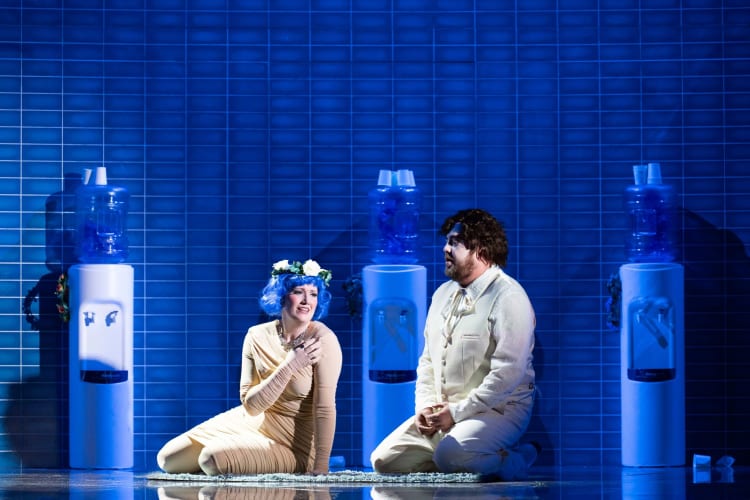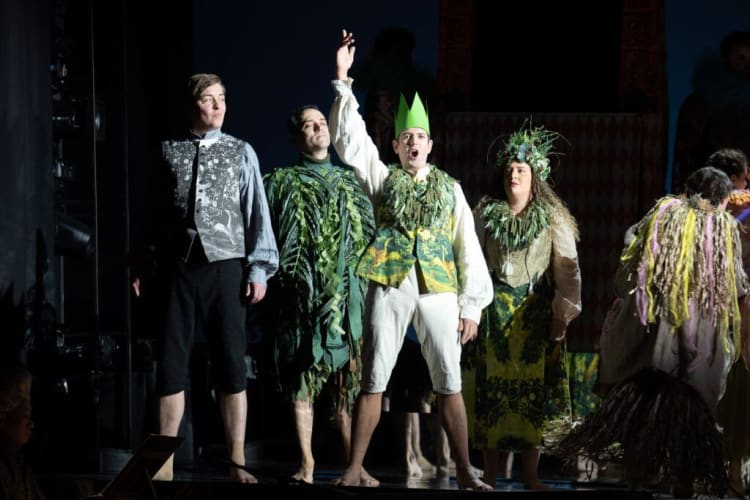For the spring season, English Touring Opera has chosen to stage two operas which take place in cities: Puccini’s breakthrough hit Manon Lescaut (1893) and Igor Stravinsky’s sole full-length opera The Rake’s Progress (1951). While these works differ in various ways, both share a keen focus on the power of the metropolis to seduce and destroy, and both have been vibrantly staged by ETO—albeit with varying degrees of success.
Jude Christian’s staging of Manon Lescaut has not generally been favoured by critics, with several commenting on its lack of narrative coherence. Unfortunately, I am not able to contradict this groundswell of opinion, but it’s only fair to address the fact that Puccini’s first full-length opera is not widely regarded as a model of plot causality, particularly when compared to the source novel by Antoine François Prévost.
In the original text, Prévost presents the reader with a clear cause-and-effect narrative in which a young woman on her way to a convent, Manon, falls in love with the penniless Des Grieux. When the latter proves unable to satisfy his lover’s taste for luxury, Manon leaves him for the older and richer Geronte. However, the desire shared by the two young lovers ultimately proves too strong, and Manon’s abandonment of Geronte sets off a chain of events which result in her inevitable demise.
This is also the plot of Puccini’s opera, but key sections are missing, resulting in bafflement for some audience members. For example, there’s a brutal jump cut between acts one and two, which means we skip from Des Grieux and Manon running off together to the latter being comfortably installed in Geronte’s Paris abode.
Frustratingly, this production of Manon Lescaut does not manage to clarify its narrative or the characters’ motivations. Instead, Christian has chosen to embrace the dream-like illogic of Puccini’s opera by framing it as a young woman’s nightmare, but this concept ultimately does not work and only serves to undermine the dramatic power of the second half.
The production is visually striking—if rather heavy-handed—with the first act taking place in an empty swimming pool decorated with water coolers. In the final act, in which Manon dies from exposure, all the water coolers are now empty. Charlotte Henery’s eye-catching costumes offer a riot of colour, but their relevance to the plot eluded me. The blue wig and unfortunate dress worn by Jenny Stafford as Manon reminded me of Marge Simpson—a peculiar reference point for a young woman about to become a nun.
Despite my reservations about the staging, Manon Lescaut is partly redeemed by the calibre of its performers. Jenny Stafford sings beautifully as the tragic title character, and she is well matched by Gareth Dafydd Morris as her ill-fated lover.
Much more successful is Polly Graham’s staging of The Rake’s Progress. Inspired by a series of paintings by the 18th-century artist William Hogarth, and boasting one of the most admired librettos in all of opera (from W H Auden and Chester Kallman), Stravinsky’s opera combines a delightfully devilish plot with a sophisticated score that references a number of earlier works.
Artfully blending dark comedy with morality tale, The Rake’s Progress focuses on the tragedy of Tom Rakewell (Frederick Jones), who succumbs to the wealth offered to him by Nick Shadow (Jerome Knox)—the Mephistopheles to Rakewell’s Faust—when he already possesses a treasure of immeasurable price in the heart of Anne Trulove (Nazan Fikret).
Unlike Manon Lescaut, Graham’s staging of The Rake’s Progress manages to include elements of surrealism without sacrificing narrative coherence. Indeed, the oddness of the imagery used in April Dalton’s set design—including Dalíesque pictures of lips and eyes—underlines the distorting and corrupting power of the big city.
Frederick Jones impresses as Rakewell, powerfully capturing his moral descent, and Jerome Knox makes for a suave and compelling Nick Shadow. Nazan Fikret is deeply moving as Rakewell’s discarded lover Anne, and Lauren Young is supremely funny and entertaining as the bearded lady Baba, whom Rakewell impulsively decides to marry and later discards.
There is also excellent work from the ensemble players, particularly during a memorable auction scene in which Rakewell’s bizarre collection of bric-a-brac is sold to pay his immense debts.
Manon Lescaut and The Rake's Progress are on tour until Tuesday 28 May.

